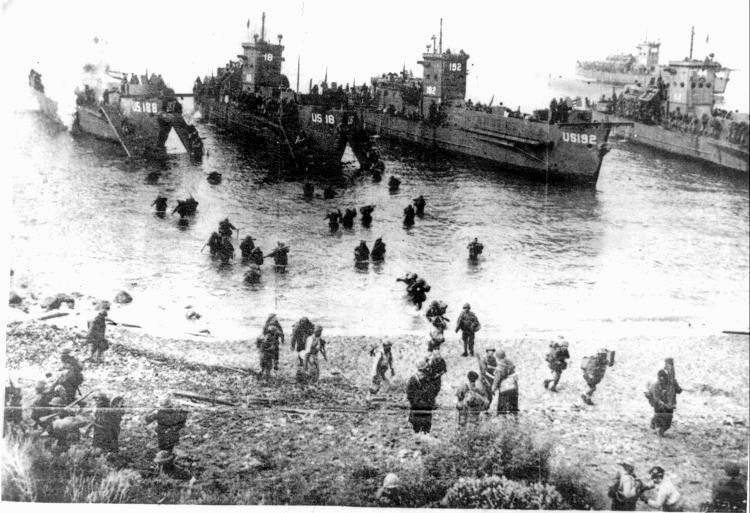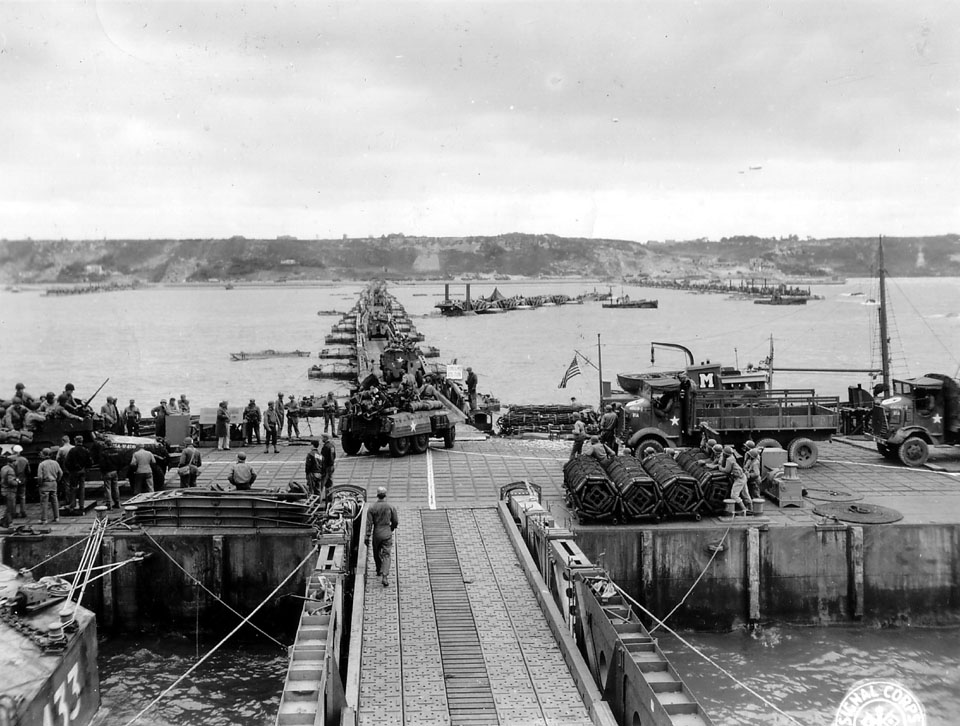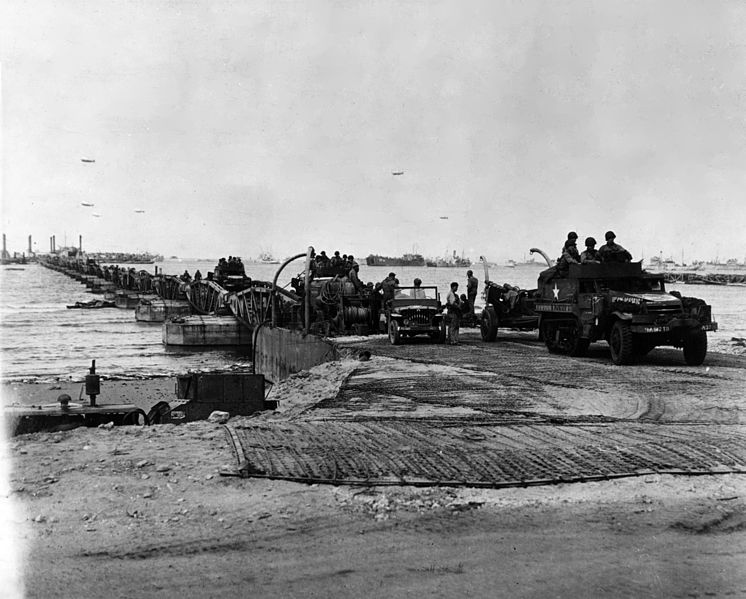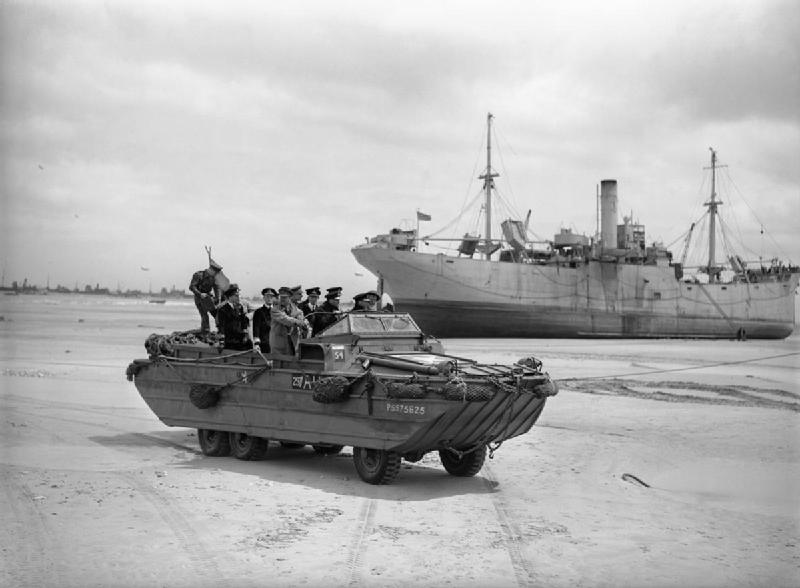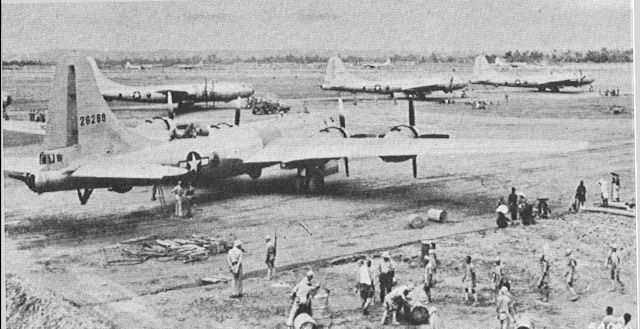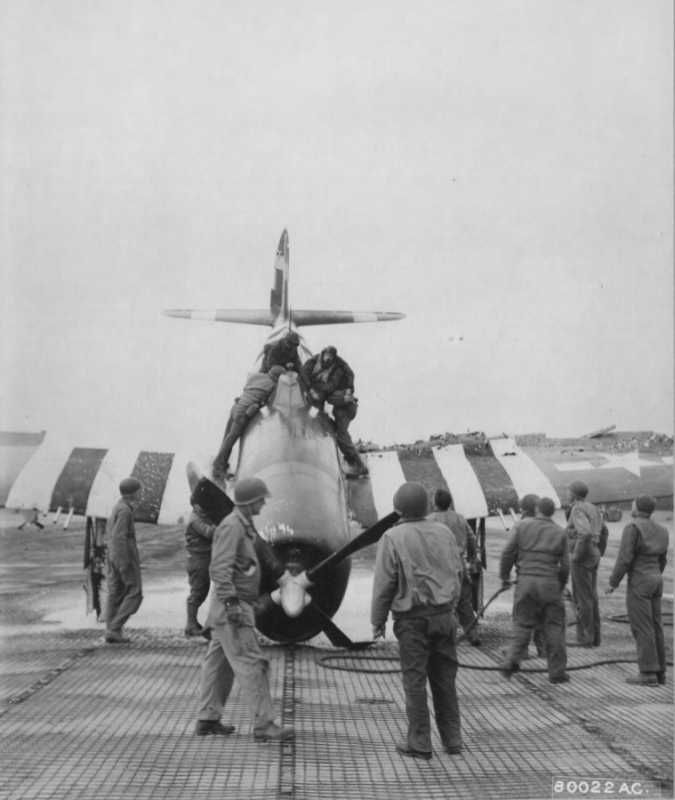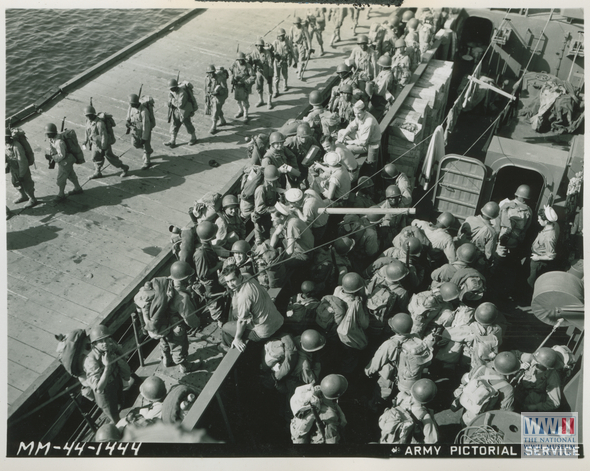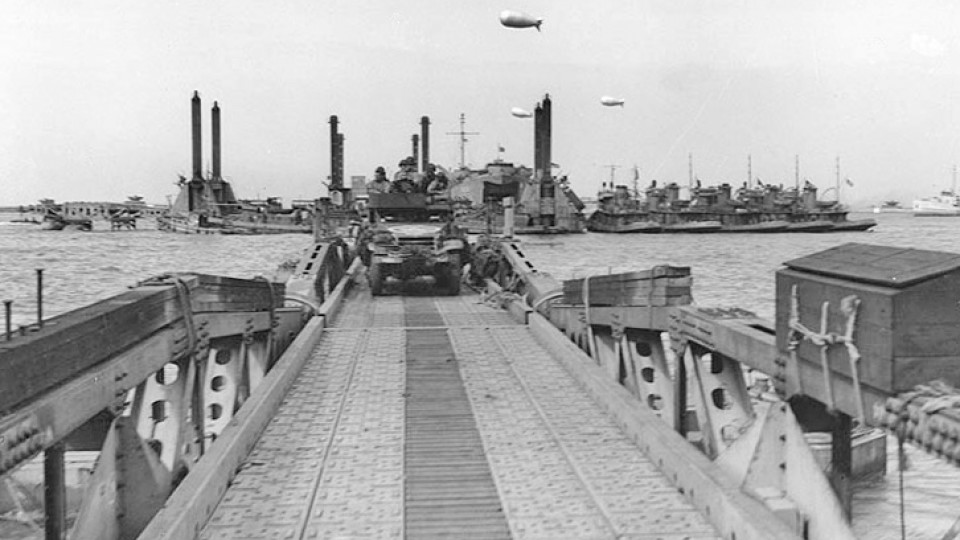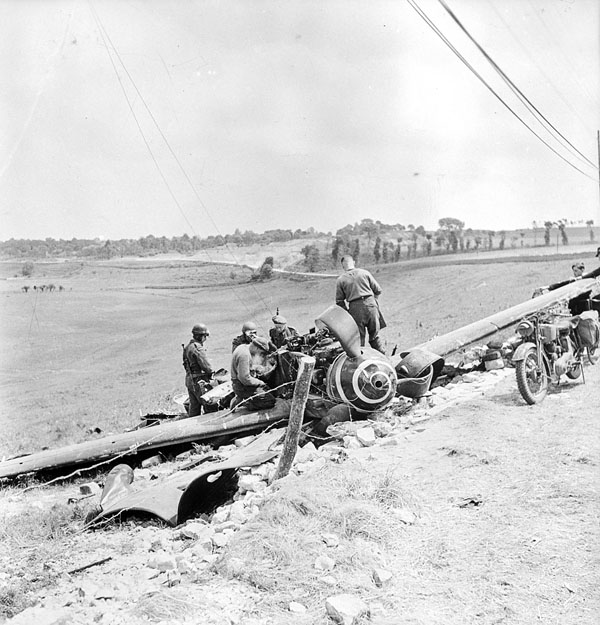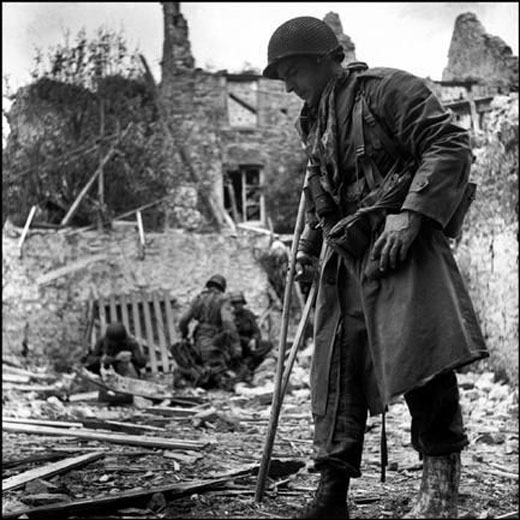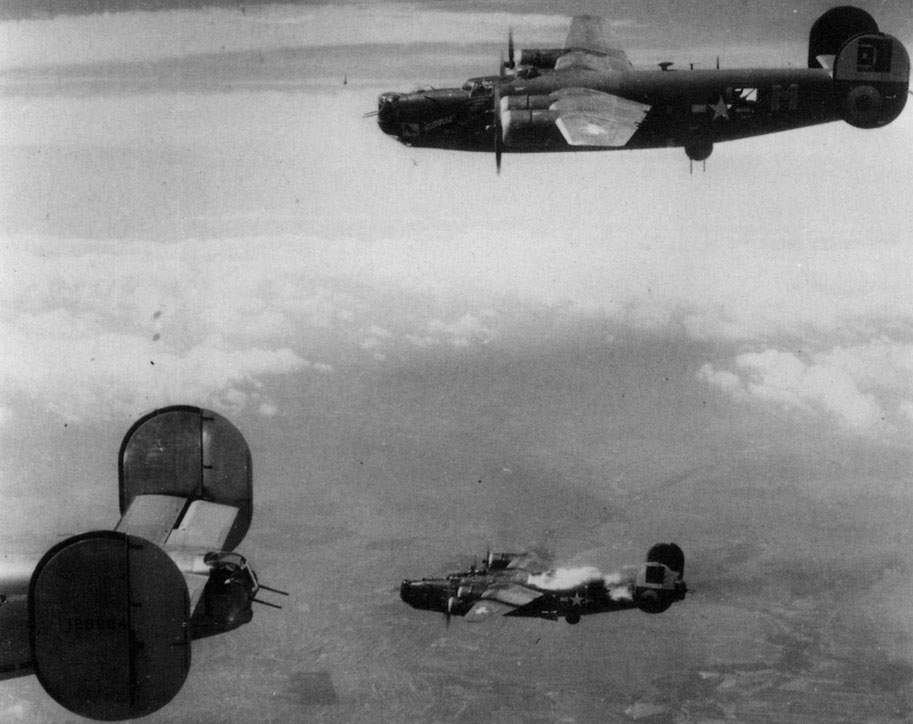Air Operations, Bonin and Volcano Islands
- Despite very bad weather, carrier aircraft from Task Group 58.1 and Task Group 58.4 are able to mount unopposed afternoon attacks against airfields, fuel supplies, and barracks on Chichi Jima, Haha Jima, and Iwo Jima.
- 2 F6Fs and their pilots are lost, one to antiaircraft fire and one in an operational accident.
- 2 VF-32 F6Fs down an H8K 'Emily' flying boat at sea at 1350 hours.
- Task Group 58.1 and Task Group 58.4 retire to the Marianas, with Task Group 58.1 refueling along the way.
- In two days of attacks, an estimated 86 airplanes are destroyed or severely damaged on the ground at Iwo Jima, and 21 seaplanes and floatplanes are destroyed at Chichi Jima.
Air Operations, Carolines
39 XIII Bomber Command B-24s attack the Truk and Yap atolls.
[Air Operations, CBI
BURMA- 28 10th Air Force fighter-bombers attack Myitkyina and targets in northern Burma.
Air Operations, Europe
Since midday on the 15th 244 V-1s have been launched against London.
RAF BOMBER COMMANDDaylight Ops:
- 2 Mosquitos of No. 100 Group carry out uneventful Intruder patrols Leeuwarden airfield.
- 405 aircraft of Nos. 1, 4, 5, 6 and 8 Groups begin a new campaign against flying bomb sites. Included in this total are 236 Lancasters, 149 Halifaxes and 20 Mosquitos. This raid is to 4 sites in the Pas de Calais area. All targets are accurately marked by Oboe Mosquitos and are successfully bombed. There are no losses.
- 321 aircraft including 162 Halifaxes, 147 Lancasters and 12 Mosquitos of Nos. 1, 4, 6 and 8 Groups, attack the synthetic oil plant Sterkrade/Holten despite a poor weather forecast. The target is covered by thick cloud and the Pathfinder markers quickly disappear. The Main Force crews can to little but bomb on the diminishing glow of the markers in the clouds. Photo reconnaissance and reports from the ground say that most of the bombing is scattered, although some bombs do fall in the plant area but do not affect production. Unfortunately, the route of the bomber stream passes near a German night-fighter beacon at Bocholt, only 30 miles from Sterkrade. The German controller has chosen this beacon as the holding point for his night fighters.
- Approximately 21 bombers are shot down by fighters and a further 10 by flak. 22 of the lost aircraft are Halifaxes. No 77 Squadron, from Full Sutton near York, loses 7 of its 23 Halifaxes taking part in the raid.
- 25 Mosquitos and 1 Lancaster of No. 8 Group are sent to Berlin, 8 Stirlings and 4 Halifaxes lay mines in the Frisians and off the Biscay coast, there are 53 Serrate, Intruder and flying-bomb patrols and there are 12 RCM sorties using the airborne Mandrel jamming screen for the first time this night.
- 1 RCM Stirling is lost.
FRANCE:
- Many scheduled 8th Air Force heavy-bomber missions are canceled because of bad weather, but 93 1st Bomb Division B-17s attack the Juvincourt, Laon/Athies, and Laon/Couvron Airdromes.
- 18 1st Bomb Division B-17s attack various railway targets of opportunity.
- 56 2nd Bomb Division B-24s attack V-weapons sites at four locations.
- 1 B-17 is lost
- 620 VIII Fighter Command fighters escort 8th Air Force heavy bombers or attack trains and troop concentrations. Making extensive use for the first time of a new fighter-bomber tactic, many fighters and fighter-bombers release their drop tanks against rail targets and set the fuel ablaze with incendiary machine-gun bullets. Of nearly 400 rail cars attacked in this manner, an estimated 200 are destroyed.
- 3 VIII Fighter Command fighters and their pilots are lost
- More than 500 9th Air Force fighters and fighter-bombers bomb and strafe rail and road traffic and bridges in the Cherbourg area. 1 Luftwaffe is downed by a 56th Fighter Group P-47 pilot.
- An advance echelon of P-51s from the 9th Air Force's 354th Fighter Group begins operating from Advance Landing Ground A-2, a wire-mesh-reinforced dirt fighter strip carved out by IX Engineer Command aviation engineers inside the Normandy beachhead near Criqueville. The P-51s immediately begin conducting low-level offensive missions against the German Army.
- 12th Air Force B-25s and B-26s attack rail and road bridges.
- XII TAC A-20s attack several ammo dumps.
- XII TAC fighter-bombers continue to attack communications targets in and around the battle area.
- 15th Air Force heavy bombers attack a number of oil depots and refineries in the Vienna area through extremely heavy and determined opposition including waves of rocket-firing Ju-88s. While covering the bombers during the penetration, target, and withdrawal phases of the mission, pilots of the 1st, 31st, 52nd, 82nd, and 325th Fighter Groups down 40 Luftwaffe fighters between 0935 hours and noon.
- 15th Air Force heavy bombers attack oil-industry targets around Bratislava.
- Escorted by 8th and 475th Fighter group P-38s that refuel at Wakde airfield, 41 38th and 345th Medium Bomb group B-25s based at Hollandia attack the airfields at Jefman and Samate at very low levels at 1255 hours. This is the longest B-25 mission yet undertaken by V Bomber Command B-25s.
- 1 P-38 is lost in aerial combat.
- 5th Air Force bombers and fighters attack the Babo airfield, Sorong, and barges and bivouacs between Hansa Bay and Wewak.
- A 348th Fighter Group P-47 downs a Ki-46 'Dinah' reconnaissance plane near Biak Island at 1050 hours.
- 8th and 475th Fighter group P-38s down 2 Ki-51s 'Sonia' bombers, 2 D3A 'Val' dive bombers, and
- 21 Japanese fighters over or near Jefman airfield between 1245 and 1300 hours.
- Intelligence from US submarines indicates 2 large Japanese naval forces (1st Mobile Fleet and a Southern Force) making a refueling rendezvous east of the Philippines, before setting sail in the direction of the Mariana Islands. The combined force totals 7 battleships, 9 aircraft carriers (4 of them light carriers), 13 cruisers and 28 destroyers. Its objective is to crush naval support of the Marianas landings. The full force of Mitscher's Task Force 58 begins redirecting itself to meet this threat.
- The Japanese submarine RO-44 is sunk by the US destroyer escort Burden R. Hastings (DE-19) in the Marshall Islands area.
- The US destroyers Melvin (DD-680) and Wadleigh (DD-689) sink the Japanese submarine RO-114 in the Marianas Islands area.
- The US high speed transport Gilmer (APD-11), on radar picket duty 25 miles west of Saipan, encounters a Japanese convoy of small cargo vessels bound for Saipan. 4 vessels are sunk including No.1 Yusen Maru, No2. Usen Maru, Toa Maru and Tatsutaka Maru. The destroyer Shaw (DD-373), ordered to support Gilmer, arrives in time to sink a fifth ship, No.17 Yusen Maru.
- The US submarine Bluefish (SS-222) attacks a Japanese convoy sinking the merchant cargo ship Nanshin Maru (1422t) in the Celebes Sea southwest of Tarakan, Borneo.
- The US submarine Bream (SS-243) sinks the Japanese army cargo ship Yuki Maru (5704t) and damages the army cargo ship Hinode Maru (1916t) off Halmahera Island.
FRANCE:
ITALY:
AUSTRIA:
Air Operations, Marianas
During the day, in response to the discovery by US submarines that a large component of the Japanese Navy’s First Mobile Fleet is sailing from the southern Philippines toward the Marianas, the US Fifth Fleet commander Adm Raymond A. Spruance, and his chief subordinates decide to reinforce the carrier antiaircraft screens with cruisers and destroyers drawn from fire-support and shore-bombardment groups as well as to shift the entire burden of responding to ground-support missions and on-call air support to aircraft based aboard Fifth Fleet escort carriers. In the meantime, carrier aircraft from Task Group 58.2 and Task Group 58.3 concentrate on neutralizing all the airfields on Guam and Tinian. This effort will ultimately fail, because pleas by experienced carrier airmen to add the power of large naval guns go unheeded.
A VF-60 F6F downs a G4M 'Betty' bomber at sea at 1440 hours.
[Air Operations, New Guinea
Burma
Units of the Chinese 50th Div capture Kamaing in the Mogaung valley. Beyond Kamaing the Chinese 38th Div links up with the Chindits of the Indian 3rd Div at Gurkhaywa.
On the Salween front the Japanese counterattack, driving the Chinese 87th Div back 3 miles. Farther north, the Chinese 2nd and 36th Divs capture Chiaotou.
[CBI
After several unsuccessful attempts to reach the isolated engineer companies at Myitkyina, survivors are able to withdraw to friendly lines on their own.
Near Ling-ling on the Burma Road, the Y Force is pushed back by a Japanese counterattack.
[China
The Japanese open their offensive against Changsha, and the garrison there, units of the Chinese 4th Army, withdraws to Paoching.
[Eastern Front
Mannerheim orders the Finnish forces in the Isthmus to retreat to the 'VKT Line' (Viipuri-Kuparsaari-Taipale).
[![]()
![]() |
| ![]()
![]() ]
]
Italy
In the British 8th Army area, XIII Corps elements meet delaying opposition at Citta della Pieve.
In the X Corps area, the Indian 8th Division, driving toward Perugia, overruns Bevagna and Foligno. Troops from the British X Corps also take Spoleto and push on to enter Spoligno as well while the Germans are still completing the withdrawal of their 10th and 14th Armies behind the Gothic Line.
On the west side American units take Grosseto.
[Marianas
At Saipan, on the north flank of the beachhead, the US 2nd Marine Div consolidates its own positions, capturing Point Afetna and the village of Charan Kanoa and joining up with the 4th Marine Div south of Point Afetna. The 4th Marine Div advances inland against strong resistance. In the previous night's fighting the Japanese lost more that 1,000 men. American guns try to silence the Japanese batteries which are firing very effectively on the beachheads from the interior of the island.
Rear-Adm Walden L. Ainsworth's battleship squadron shells enemy installations on Guam. Meanwhile Vice-Adm Raymond A. Spruance puts back the date for the invasion of Guam, in the knowledge that a big fleet under the command of Vice-Adm Jisaburo Ozawa is about to arrive there.
[Mediterranean
The British submarine Sickle is lost, probably on a mine in the Kythera Channel, around this date. The entire crew of 48 are lost.
[New Guinea
Allied commanders meet to consider the invasion of Noemfoor. 30 June is tentatively choses as D-Day
On Biak, TF HURRICANE continues its attack with the 2nd Battalion of the 186th Infantry making the main effort. The battalion closes a gap on a low ridge and develops the western limits of the enemy's West Caves position before withdrawing for the night.
[Norwegian Sea
Three Mosquitos of No 333 Squadron RAF are on anti-U0boat operations when U-998 is sighted. One of the aircraft delivers a cannon and depth charge attack which leaves the U-boat leaking oil and steering erratically before diving. The bows then reappear and a second attack is delivered at which time the bows sink. Although the U-boat is able to make it back to Bergen, the damage is so severe it cannot be repaired.
| Class | Type VIIC |
| CO | Kapitänleutnant Hans Fiedler |
| Location | Norwegian Sea, NW of Bergen |
| Cause | Air attack |
| Casualties | None |
| Survivors | 51 |
Pacific
Western Front
The American VII Corps reaches the Douve River and succeeds in establishing a bridgehead across it. After formidable German opposition and bitter street fighting units of the 82nd Airborne Div enter St Sauveur-le-Vicomte, on the west bank of the Douve. The Germans withdraw in disarray. In the American XIX Corps sector, while some units man the canal linking the Taute and Vire Rivers, the 29th Div, with the V Corps' 2nd Div, advances in the directon of St Lô. In other sectors all the Allied forces continue to press forward.[WF] King George VI visits the forces.[CAEN]
[Images from June 16, 1944
|
|
|
|
|
|
|
|
|
|
|
|
